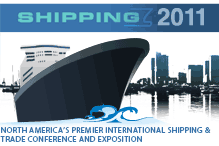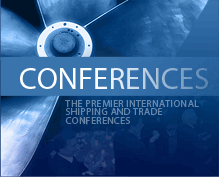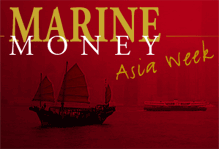
Euroseas Balances Growth with Reward
In Monday’s earnings release, Euroseas affirmed its intention to further renew and expand its fleet and acknowledged that attractive opportunities are emerging. In particular, management appears to be focused on 1,700 TEU containerships, whose prices are at 10-year lows.
To better position themselves, the Board in an effort to preserve cash decreased the dividend “towards the lowest range the Board considers satisfactory.” Specifically, the dividend was reduced from $0.10 to $0.05 per share, which still yields about 5% based upon the recent levels of the share price. And as a testament to its balance sheet and strategy, it remains one of the few shipping companies still paying a dividend
Continue Reading
George Jumps into a Convertible
DryShips announced on Tuesday that it intends to offer $300 million aggregate principal amount of convertible senior notes under its previously filed shelf registration. In addition, the underwriter will be granted an option to purchase up to an additional amount of $45 million of the notes to cover over-allotments. Proceeds of the notes will be used for vessel acquisitions, working capital and general corporate purposes.
Continue Reading
Not to Be Outdone
Navios Maritime Partners announced after the market closed Wednesday that it intended to issue 4 million common units with a green shoe of 600 thousand units. Proceeds would be used for fleet expansion and/or general partnership purposes. The deal was priced today at $14.90 per unit, a discount of 5.8% from the prior close.
Joint book running managers were Citi and JPMorgan with S. Goldman Advisors, DVB and Cantor Fitzgerald serving as co-managers.
Teekay LNG goes to the Shelf
Having filed its F-3 shelf registration on October 20th (effective on the 29th), Teekay LNG Partners wasted no time and announced on Monday the offering of 3.5 million common units with a green shoe of a further 525,000 shares. On Tuesday the company announced that the shares were priced at $24.40, which is a discount of about 5% to Monday’s close at $25.67 just before the announcement.
Continue Reading
Our Intrepid Asian Traveler Reports From Qingdao
We admit to a healthy respect and some awe at the economic might flexed daily in the Asian world. The constant clang of steel in Singapore’s development, the sheer size of HK’s real estate development, the Rolls Royce style quality of an Imabari 28k handy, or the spread of newbuildings at Hyundai Heavy – so many it dwarfs the number of big commercial ships built in the entire US throughout this writer’s entire career.
This week Qingdao, with its vast and historic port, its world class clients and shipping partners hosted Cosco‘s World Shipping Summit (please note the organizers in perhaps a nod to modesty call it the World Shipping (China) Summit – believe us China is an identifier not a limiter!) and out did them all for these two days. 900 guests, every major liner company, financial institutions, yards, ports, railroads, government ministries, trade associations came and were delighted.
The hospitality was delightful but the messages of confidence, recovery, environmental protection and the enormous value of open world trade were powerful. And for those who know Captain Wei Jiafu know also the passion, conviction and energy with which they were delivered.
Partnership, customer service, innovation, corporate alliances and repeated calls for scrapping served as inspiration.
What’s Wrong with “Quiet Enjoyment”?
As is to be expected with the U.S. and U.K postal services involved, an old issue of Lloyd’s List arrived this week with the blaring headline, “Maersk Lines’ quiet enjoyment clause sparks lender discontent.” We don’t understand why that would be the case since the clause has been around forever and is, in fact, indirectly beneficial to lenders.
First, what does quiet enjoyment mean? Although it more commonly appears in real estate law, in this context, the phrase refers to the legal right to the undisturbed use and enjoyment of leased property by the lessee or charterer. The charterer in exchange for entering into a long-term agreement with the owner expects, quite reasonably so, to have unfettered use of the property. What incentive would it have to enter into an agreement where its service or trade could be disrupted? The quid pro quo for this is, of course, that the charterer meets all its obligations, including the payment of hire, under the charter.
And, just as importantly, it should also be acknowledged that the uninterrupted use of the vessel is also in the banker’s interest as it insures the certain flow of charter hire, which provides the cash flow to pay the loan.
QInvest & Fortis Fund
With each party contributing $50 million, QInvest, Qatar’s leading investment bank, and Fortis Bank Nederland formed a joint venture, QInvest-Fortis Bank Nederland Shipping Fund, which will provide Sharia’a compliant tailor made financing solutions to the shipping industry. The fund will be jointly managed by Fortis and QInvest and will open soon to third party subscriptions. The fund is tailored to provide attractive, yet secure and stable returns to investors while offering portfolio diversification. Continue Reading
TOPS Problems Continue
In its 3rd quarter earnings release, Top Ships reported that it was in breach of its loan covenants and is in discussions with all of its banks to receive waivers for these breaches as well as to extend existing waivers that were scheduled to expire in 2010 and 2011.
Previously, the company had received waivers and amended the loan agreements with its five leading banks with respect to covenant breaches dating back to December 31, 2008. However, the company is now in breach of additional covenants relating to EBITDA, minimum liquidity, adjusted net worth and LTV as it relates to the product tankers.
Being Conservative, TBS Reclassifies
Following the accounting rules, TBS International reclassified its long-term debt as current. According to GAAP, long-term loans must “be classified as a current liability when either a covenant violation that gives the lender the right to call the debt has occurred at the balance sheet date, or such a covenant violation would have occurred absent a waiver of those covenants, and in either case it is probable that the covenant violation will not be cured within the next 12 months.”
Although the Company was in compliance with all modified additional covenants and the debt is not currently callable, the Company would have been in violation of the previously effective minimum consolidated fixed charge coverage ratio and the maximum consolidated leverage ratio. Moreover, based upon current internal projections, management anticipates that it is likely that the original covenant requirements will not be met during the next twelve months. Accordingly, long-term loans are classified as a current liability in the September 30th balance sheet.
Satisfied!
The 3rd quarter report is in and DVB Bank SE declares itself to be satisfied with the overall result. And they should be as the transportation and financial markets continue to struggle amidst a recession. On a positive note, “less pronounced competition allowed (the bank) to enter into numerous new exposures where returns once again adequately reflect the risk involved.” Nevertheless new business volume was down to EUR 2.02 billion compared to Q3 2008, which was EUR 5.12 billion. On the other hand, the average interest margin on new Transport Finance business increased from 178 bps to 335 bps.
By shifting to quarterly fixings and using interbank rates, DVB has continued to mitigate the impact of money market distortions reducing this additional cost burden to a mere EUR 1 million in this quarter, following EUR 17.3 million in the first quarter and EUR 2.3 million in the 2nd quarter. Nevertheless, ROE was severely impacted by these distortions declining 6.7% to 11.4% versus the comparable quarter from the prior year.
But, perhaps more importantly given the environment, DVB increased its capital ratios with its tier 1 ratio rising from 13.9% at year-end to 15.4% and the total capital ratio increasing to 19.8% from 18.2% also at year-end.







